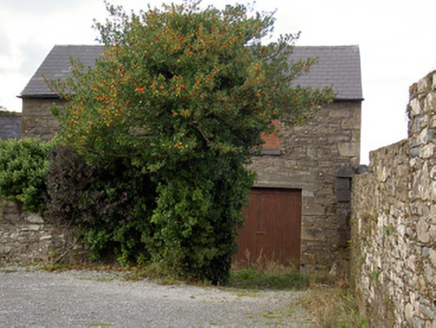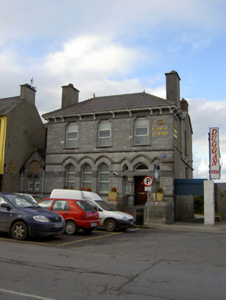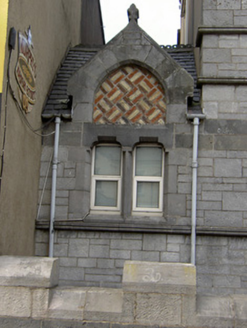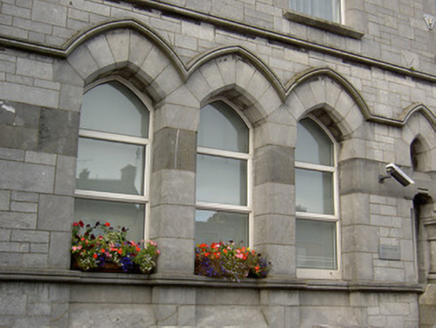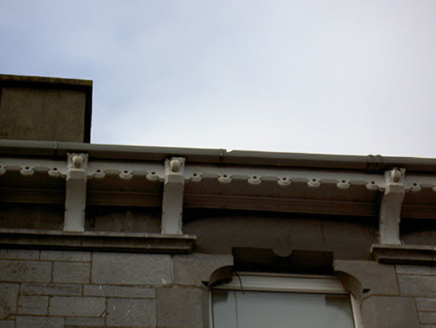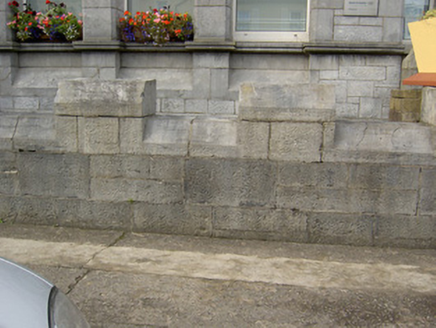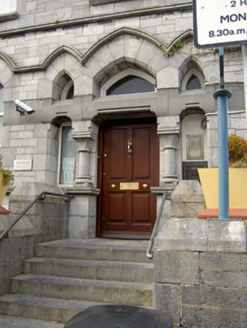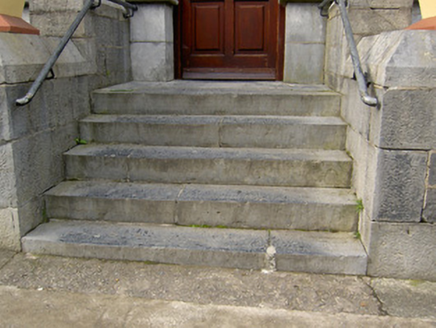Survey Data
Reg No
20817008
Rating
Regional
Categories of Special Interest
Architectural, Artistic, Scientific
Previous Name
National Bank of Ireland
Original Use
Bank/financial institution
In Use As
Bank/financial institution
Date
1875 - 1880
Coordinates
127340, 90308
Date Recorded
03/10/2006
Date Updated
--/--/--
Description
Detached two-storey double-pile bank and manager's house, built c. 1878, having three-bay first floor with doorway and group of three windows to ground floor, and having single-bay single-storey gable-fronted bay to west. Hipped slate roof to front pile, pitched to rear, with cast-iron ridge crestings, rendered chimneystacks, cast-iron rainwater goods, overhanging eaves, front pile having carved limestone cornice and decorative timber bracketed eaves course. Pitched roof to rear with red brick chimneystacks and render eaves course. Pitched slate roof to linking bay with cast-iron ridge crestings and carved limestone gable to front with carved limestone finial and coping, pointed arch recessed panel with chamfered surround and decorative polychromatic patterned brick inset. Snecked dressed limestone walls to front pile with carved limestone string course between floors and to lintel level of first floor, continuous carved hood-moulding course to ground floor, and dressed limestone quoins. Rendered walls to rear and side elevations. Shouldered square-headed window openings to first floor of front elevation with dressed and chamfered block-and-start surrounds, carved limestone sills and replacement uPVC windows. Group of three Tudor arch window openings to ground floor with dressed limestone block-and-start surrounds, chamfered limestone voussoirs, carved limestone continuous sill course and replacement uPVC windows. Paired shouldered square-headed window openings to single-storey bay with chamfered dressed limestone surrounds and sills and replacement uPVC windows. Square-headed window openings to rear and west elevation with replacement uPVC windows, and stone sills. Round-headed window opening to rear with cut limestone sill and coloured-glass margined one-over-one pane timber sliding sash window with fanlight. Shouldered square-headed door opening to front elevation with flanking shouldered square-headed sidelights, all having carved and chamfered limestone surrounds, continuous darker limestone lintelling with roll mouldings and having carved limestone engaged columns flanking doorway with square-profile plinths and carved caps. Pointed arch overlights to sidelights and Tudor arch overlight to door, all above limestone lintelling, with chamfered dressed limestone voussoirs. Timber panelled door, replacement uPVC window to one sidelight, and night safe to other. Approached by flight of cut limestone steps. Bank set back from street with dressed limestone castellated boundary walls with carved limestone copings. Detached three-bay two-storey outbuilding to rear, built c. 1890, having pitched artificial slate roof, rubble stone walls with dressed limestone quoins and having exposed red brick chimneybreast to gable, square-headed window openings with red brick surrounds and voussoirs, concrete sills and one with timber fittings, and square-headed door opening to front with concrete lintel, dressed limestone surround and replacement timber door. Rubble stone wall at right angles to front elevation with camber-arched pedestrian entrance with red brick surround and voussoirs.
Appraisal
Designed by Brett and Sons, the limestone construction and Venetian Gothic style of this bank building make it a striking and imposing feature on Millstreet's Main Street. The austerity of the stone façade is offset by the decorative emphasis of the openings, as well as the roof dressings. The Gothic style is unusual for financial architecture in Ireland, which tended to favour Classical elements. The limestone construction and dressings here lend an air of authority to the building and give it a sense of elegance and authority. The exposed stone construction and simple design of the outbuilding contrasts markedly with the bank.
